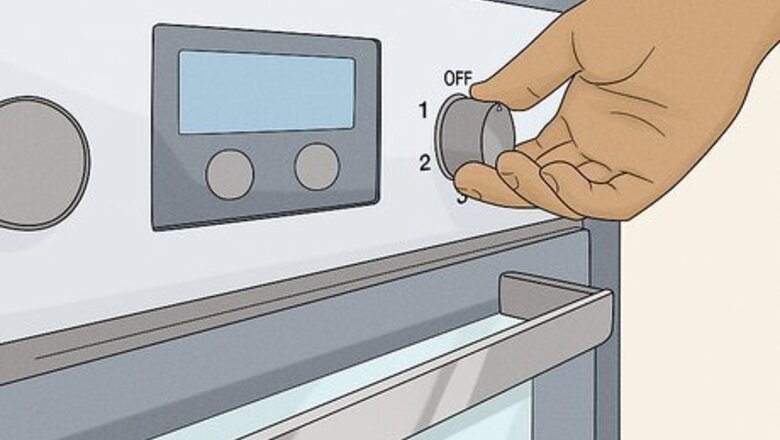
views
Taking Advantage of Warnings
Remember that you only have a few seconds between an earthquake warning and feeling actual shaking. You may feel shaking before or after receiving such a warning. You may even feel shaking with no warning! Regardless, remember that earthquake early warnings give you limited time and do not predict earthquakes. You may get a warning anywhere from a few seconds to up to a minute before an earthquake hits.
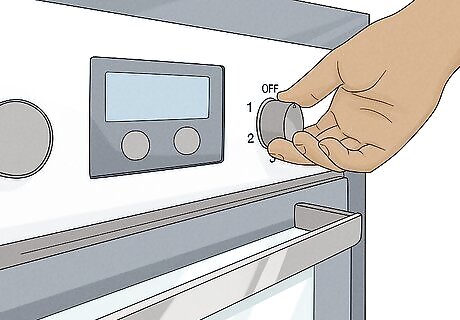
Turn off cooking appliances if it is safe to do so before taking cover. These appliances can potentially start a fire if left unattended. Make sure all controls on stoves, ovens, and microwaves are set to OFF before seeking cover.
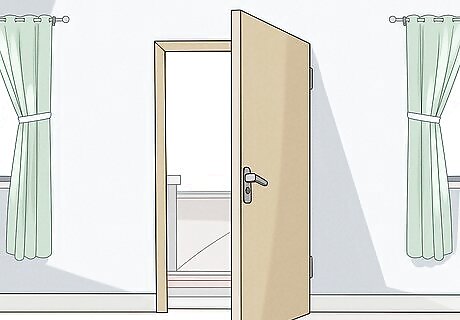
Open exit doors if you can before tremors start. This will prevent them from jamming, leaving you with a possible evacuation route.
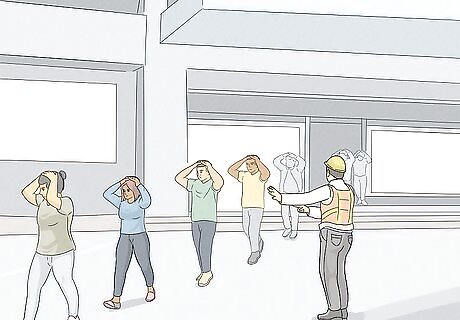
Follow instructions of emergency personnel if in a public building. They may provide you additional things that you need to do to protect your lives. For example, they may inform you to turn off dangerous machinery or to move away from shelves or displays.
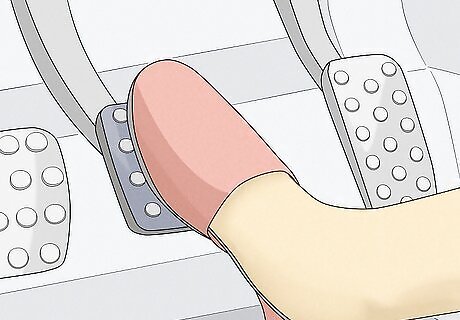
Slow down your vehicle if in a car. Avoid sudden braking or swerving, as it could potentially cause an accident.
Taking Cover Indoors
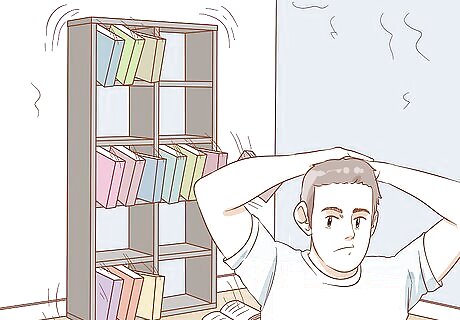
Get away from glass, large furniture, and other hazards, if possible. In the first few seconds after the shaking starts, try to quickly move away from anything that could fall and injure you. Get low and walk or crawl away from hazards such as windows, cabinets, televisions, and bookcases. If you're in a crowded public place, such as a store, do not rush toward the exits, even if you see lots of people doing so. Get away from display racks, glass, and exterior walls, and find a covered spot to take shelter. Remember the phrase “Drop, Cover, Hold on,” which is the course of action recommended by U.S. and international emergency management organizations. Fire alarms may sound as earthquakes can mess with fire alarm systems, but it is best to stay where you are and wait until the shaking stops.

Drop to your hands and knees under a sturdy table or desk. Look for a sturdy piece of furniture, such as a solid table, that can offer cover from falling objects. Get down on your hands and knees, and crouch under the desk or table until the shaking stops. If you're in bed during an earthquake, stay there. Brace yourself, and protect your head and neck with a pillow. If you can't get under a sturdy table or desk, take cover in an interior corner of the building. Don't stand in a doorway. This is was recommended in the past, but you're safer under a sturdy table or crouched in a corner. A doorway doesn't offer much protection from falling or flying objects, which cause the most earthquake-related injuries and deaths.

Protect your head and neck from falling debris. If possible, grab a pillow, sofa cushion, or another object to shield your face and head. If there's nothing nearby to use as a shield, cover your face, head, and neck with your hands and arms. A strong earthquake can kick up clouds of dangerous dust. If this is the case, you should also cover your nose and mouth with a handkerchief or an article of clothing.
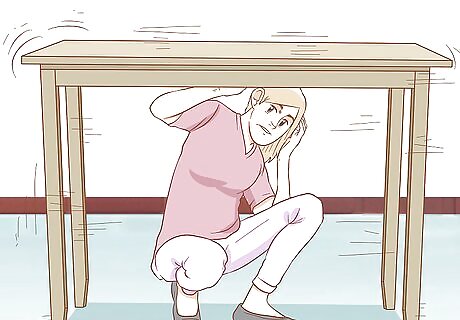
Remain in your safe spot until the shaking stops. Stay put until the shaking has stopped for 1 or 2 minutes. Remain on guard when you get up, as aftershocks can occur at any time after an earthquake. In the event of an earthquake, you and your family (or coworkers, if you're at work) should meet in a designated safe location. Create an action plan in advance, and head to the designated meeting place once the shaking has stopped. If an aftershock occurs, drop, cover, and hold on until it stops.
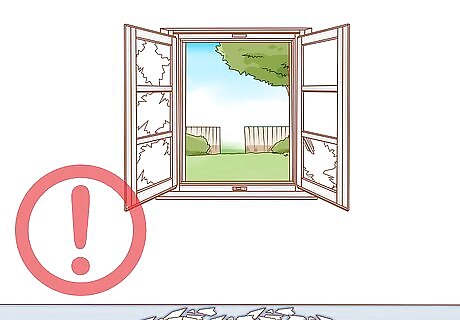
Use caution around debris after leaving your shelter. Watch out for broken glass and rubble. If you're not wearing shoes, tread lightly, and be extremely careful not to injure yourself. Grab a pair of heavy-soled shoes and, if you're wearing light clothing, put on a pair of pants and a long-sleeved shirt. In a strong earthquake, remember to cover your mouth to avoid inhaling dust, especially if you have a history of any respiratory diseases. If you're trapped, don't shout, as you'd risk inhaling dust. Instead, send a text or call emergency services, tap on a hard surface, or, if you have one, blow a whistle to alert first responders of your location.

Check for injuries and render aid, if needed. Call emergency services if you or someone nearby are injured and need medical attention. If you know first aid or CPR, administer emergency care as needed. To perform CPR, place one hand over the center of the person's chest, and hold your other hand over the first. Keep your arms straight as you press directly into their chest at a rate of about 100 beats per minute. Stop bleeding by applying direct pressure to the wound. Pack the wound with sterile gauze or a clean cloth and apply firm pressure. If firm pressure doesn't stop the bleeding, use a belt, article of clothing, or bandages to fashion a tourniquet. Wrap the tourniquet 2 to 3 in (5.1 to 7.6 cm) above the wound toward the torso. For a wound on the thigh, wrap the tourniquet above the wound near the groin to limit the amount of blood flowing from the heart. If someone is seriously injured or unconscious, don't move them unless the building is structurally unsound or they're otherwise in immediate danger.
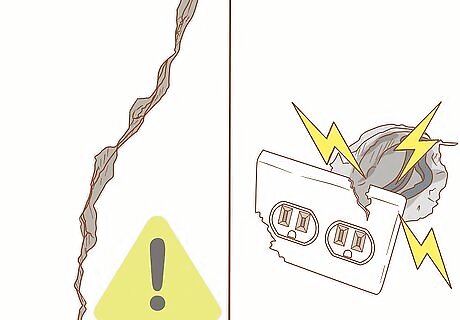
Inspect the building for structural damage and hazards. Check for cracks in the building's structure, fires, the smell of gas, and damaged wires or electrical appliances. If you believe the building is unsound, evacuate immediately. If possible, and if there's no immediate threat that the building will collapse, respond to any utility hazards. If you smell gas or hear a blowing or hissing noise, open a window and quickly leave the building. Turn off the gas at the main valve outside and call the gas company. Note that a professional will be needed to restore service. Look for signs of electrical damage, including sparks, broken or frayed wires, and burning smells. If possible, turn off the electricity at the main fuse box or circuit breaker. If you'd have to step in water to access the fuse box or circuit breaker, call an electrician instead of approaching it yourself. Put out any small fires with a fire extinguisher. If there's a larger fire, call emergency services. Evacuate immediately if there's a fire and you smell gas. Don't drink water from the sink, bathe, or use the toilet until your local authorities have advised that it's safe to do so. Plug the drains in sinks and bathtubs to prevent sewage backflow.
Riding It out in a Vehicle
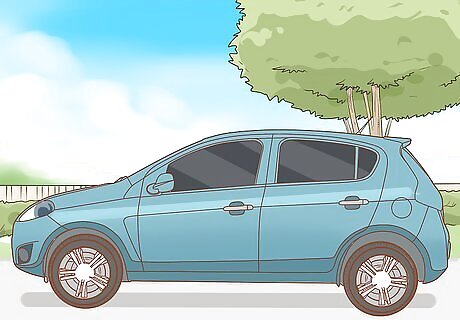
Stop in a clear area away from trees, buildings, and other structures. Find an open area and stop your vehicle on the shoulder or side of the road. Get as far away as you can from utility poles, large structures, bridges, and any other potential hazards. Pay attention to surrounding traffic, and stop only when it's safe to do so. Don't stop abruptly, or vehicles to the rear might collide with you.
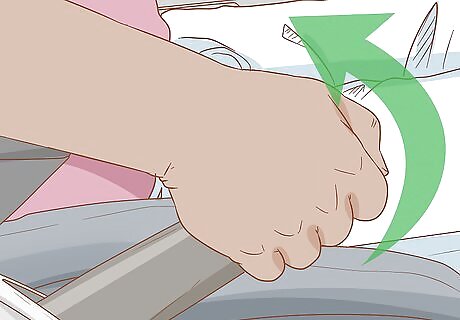
Set your parking brake and wait until the shaking stops. The car may jiggle violently during an earthquake, but stay put and try to remain calm. You're safer in a car than outside, since vehicles offer protection from debris and falling objects. Turn on your radio, as channels should be broadcasting emergency broadcast information.
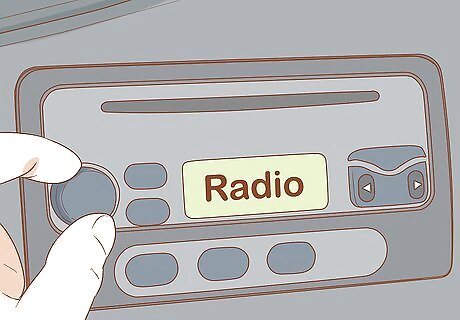
Beware of damaged roads, debris, and other hazards when you continue driving. Listen for reports of road closures or hazards on the emergency broadcast. When the shaking stops, resume driving and keep your eye out for damaged roadways, sinkholes, unsound bridges, and any other potential hazards. If a power line has fallen on your vehicle or you're otherwise unable to travel, stay put. Call emergency services, and wait for first responders.
Staying Safe Outdoors

Move away from buildings, street lights, power lines, and bridges. The most dangerous locations during an earthquake are areas immediately around buildings. As soon as the ground begins shaking, try to get as far away as possible from any nearby structures. Stay low to the ground to keep your balance as you get to a safe spot, and keep your eye out for falling debris. Do not seek shelter under a bridge or overpass. Additionally, look out for sinkholes, open faults, or large holes in the ground.
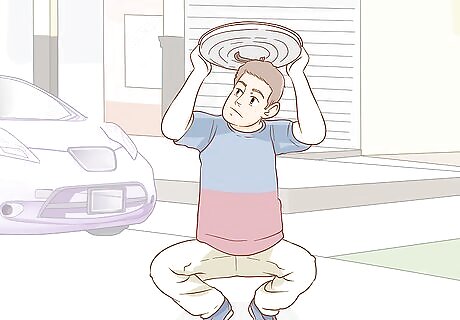
Crouch down low in a wide open area until the shaking stops. Once you've made your way away from nearby structures, get on your hands and knees and cover your head. See if there are any objects nearby to use as a shield, such as a trash can lid. If none are available, cover your head and neck with your hands and arms. Remain crouched low to the ground in a covered position until the shaking stops.
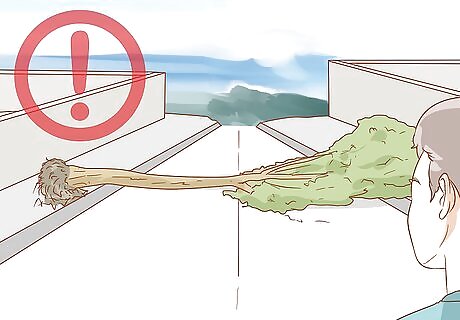
Watch out for hazards as you assess your surroundings. As you venture out after the earthquake, beware of broken glass, rubble, downed power lines, fallen trees, and any other potential hazards. Check yourself and anyone nearby for injuries. If necessary, administer first aid and call emergency services. Stay away from damaged structures and areas immediately around buildings. Remember that aftershocks may occur. If there's an aftershock, weakened buildings, windows, and architectural details can fall to the ground.

Get to higher ground if you're on the shore or near a dam. If a shaking lasts more than 20 seconds, don't wait for an alarm or warning to flee. Get to ground that's at least 100 ft (30 m) above sea level or 2 mi (3.2 km) from the shore. Earthquakes can cause tsunamis, so put distance between yourself and the coast. While a catastrophic failure is unlikely, earthquake damage can cause flooding downstream from a dam. If you live in a flood zone, proceed to higher ground. Check evacuation plans in advance if you live near a dam in an earthquake-prone area.
Preparing for an Earthquake
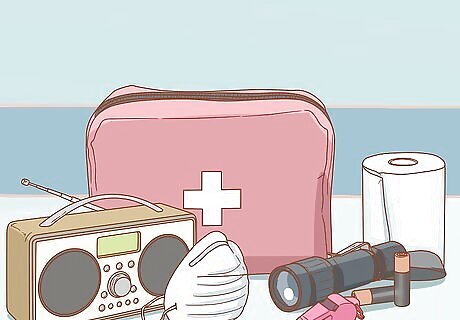
Make an emergency supply kit. Keep your supplies in an easily accessible spot, such as a hall closet or garage. Make sure every member of your family knows where your emergency supplies are located. Keep the following items on hand: Enough bottled water and non-perishable food to last 3 days. A first aid kit, including gauze, alcohol or hydrogen peroxide, tweezers, ibuprofen or another pain reliever, cotton swabs, anti-diarrhea medication, sanitary napkins, and eyewash. Medications that any members of your family take regularly. A flashlight and extra batteries. Tools, including a screwdriver and adjustable wrench. A whistle, to alert first responders in the event you become trapped. Clothes and blankets. Your pet's food and medication, if you have one.
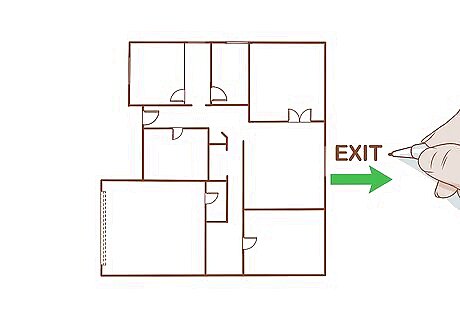
Create a family survival plan for your home. You and anyone you live with should have a plan to quickly get to safety in the event of an emergency. Instruct every member of your household to drop, cover, and hold on, then to head to a designated meeting location when the shaking stops. Designated spots might be a clearing near your home, a school, community center, or a shelter. Make a plan to reunite ahead of time, as phone service may be limited and should be used only for emergencies. Conduct practice drills every 6 months to ensure you and your loved ones know exactly what to do in the event of an earthquake.
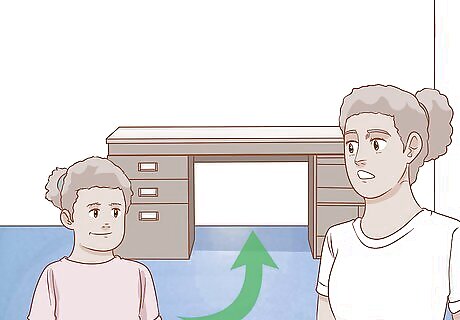
Identify safe spots and hazards in each room of your home. Look for tall cabinets, televisions, dressers, bookcases, hanging plants, and other objects that could fall and cause injury. Go room by room with your family members, and note spots that offer protection and those that are potentially dangerous. For example, if there's a heavy desk in your child's bedroom, tell them to take cover under it. Advise them to stay away from their windows and dresser.
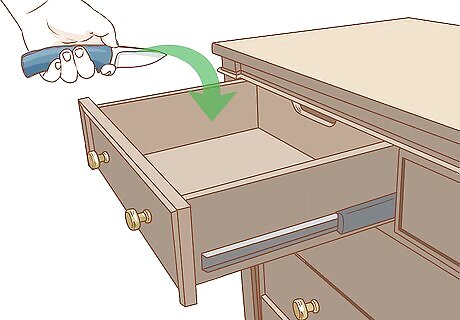
Store dangerous objects in a secure cabinet or on lower shelves. Avoid storing heavy objects high up, and install brackets to secure tall furniture to walls. Keep any dangerous items, such as sharp objects, glass, and flammable or toxic substances in locked or low cabinets. Objects such as knives or corrosive liquids can cause serious injury, especially if they fall from a high storage spot during an earthquake.
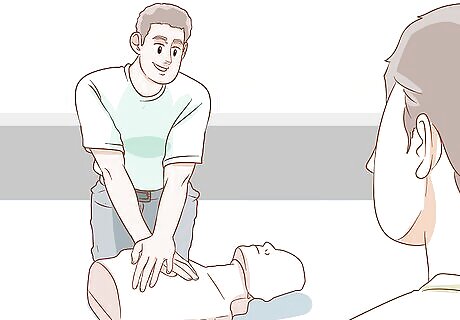
Take first-aid and CPR classes to become certified. If someone nearby is hurt in an earthquake, basic knowledge of first aid can be a lifesaver. A CPR certification will prepare you to respond if the worst happens. Look online for nearby classes, or check with a local clinic or Red Cross chapter.
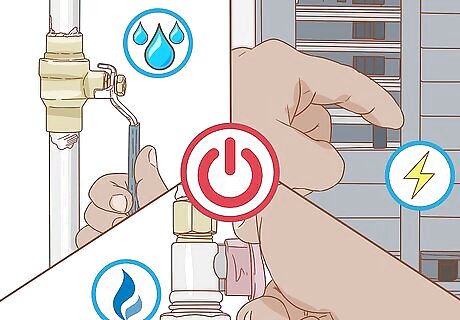
Learn how to shut off the water, the electricity, and the gas. Earthquakes can damage utilities and cause flooding, fires, or explosions. If you're not sure how to shut off your utilities, call your service providers for specific instructions. To shut off electricity, turn off individual circuits or fuses at the main box, then turn off the main circuit or fuse. Your gas main should be near your gas meter, but locations vary. Use an adjustable wrench to turn the valve 1/4 turn clockwise. Your water main should be at your water meter by the street or sidewalk, but it may be inside your home. Turn the valve 1/4 turn clockwise to shut off your water.

















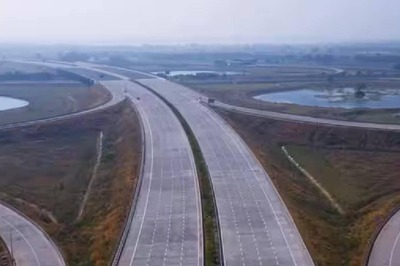

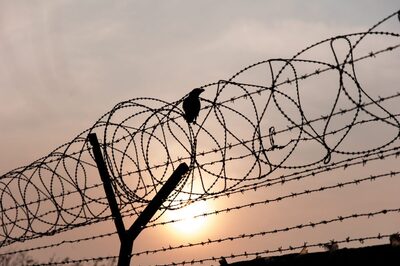
Comments
0 comment